|
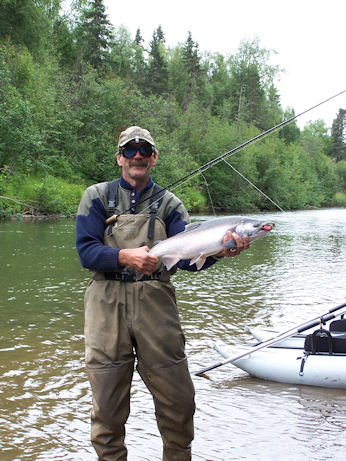
By Ard Stetts for The Real Skinny
Iíll open this installment for Salmonfly.Net by
asking readers if their salmon fishing experiences are different
from what they envisioned before casting the first fly in hopes of
landing the BIG one.
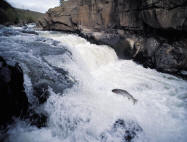 For me, my first salmon fishing adventure was nothing like the pristine accounts I had read about when I was young. I headed to Maine with certain perceptions and expectations of what the fishing was going to be like. I read many tales about fishing for salmon, and all the beautiful flies invented long before I was born.
Visions of one of my own ďJock ScottsĒ gracefully swinging through crystal clear water to the lie of a magnificent waiting fish dominated my thoughts. It was the 1970ís and there were rumored to be a few Atlantic salmon in the mighty Penobscot River. I took my trip in the fall, knowing that Maine would offer a mixed bag. If the Atlantic salmon effort did not go as planned, I would have the landlocked variety to fish for in the north central part of the state. For me, my first salmon fishing adventure was nothing like the pristine accounts I had read about when I was young. I headed to Maine with certain perceptions and expectations of what the fishing was going to be like. I read many tales about fishing for salmon, and all the beautiful flies invented long before I was born.
Visions of one of my own ďJock ScottsĒ gracefully swinging through crystal clear water to the lie of a magnificent waiting fish dominated my thoughts. It was the 1970ís and there were rumored to be a few Atlantic salmon in the mighty Penobscot River. I took my trip in the fall, knowing that Maine would offer a mixed bag. If the Atlantic salmon effort did not go as planned, I would have the landlocked variety to fish for in the north central part of the state.
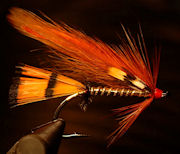 The
Penobscot was high with rain water and much larger than I had ever
anticipated. After spending
a day looking for an area where a person could wade to fish, I gave
up and traveled to
Greenville
Maine where I fished all the
rivers in that area that I could manage. Some of the better were the
Moose, the
Kennebec, and the Roach rivers. Here I found
that fishing my artistically constructed featherwing streamers was
not as easy as I had thought it would be. Weight was going to be
needed, and a lot of it. Like the big Penobscot, these rivers were
deep and swift. I caught a good number of landlocks, some of which
were large. Back in the seventies there were quite a few big
landlocked salmon in Piscataquis County Maine. My success was no
doubt due to the sheer numbers of fish making their spawning run,
not a result of my knowing what I was doing. That has been many
years ago now, but the difficult conditions in which we must fish
for salmon are much the same. The
Penobscot was high with rain water and much larger than I had ever
anticipated. After spending
a day looking for an area where a person could wade to fish, I gave
up and traveled to
Greenville
Maine where I fished all the
rivers in that area that I could manage. Some of the better were the
Moose, the
Kennebec, and the Roach rivers. Here I found
that fishing my artistically constructed featherwing streamers was
not as easy as I had thought it would be. Weight was going to be
needed, and a lot of it. Like the big Penobscot, these rivers were
deep and swift. I caught a good number of landlocks, some of which
were large. Back in the seventies there were quite a few big
landlocked salmon in Piscataquis County Maine. My success was no
doubt due to the sheer numbers of fish making their spawning run,
not a result of my knowing what I was doing. That has been many
years ago now, but the difficult conditions in which we must fish
for salmon are much the same.
Here in Alaska,
you would think that catching wild salmon would be a pretty easy
task. Back in 1950, fishing alone on the river bank in the Last
Frontier, you could catch one every cast. But this is 2009, and you
will not be alone in most cases.
I quickly discovered that all the experience I had fishing
for trout and salmon would need to be mustered.
I needed to adapt some new strategies. Just like my early
experiences with deep swift water, the rivers here are often swelled
with either snow melt or rain water. Once again I find that the
fishing isnít always like you wish it would be.
There
are some well known places where salmon runs of incredible
proportions still occur, but year by year they are beginning to show
signs of waning. The Russian River on the Kenai Peninsula
is still receiving two runs of sockeye salmon every year that
sometimes fill the channel to mind boggling levels. But the number
of fishermen increases each year also. If you choose the Russian as
one of your destinations for salmon fishing you will be one of
literally thousands of people who will crowd the little stream this
season. So what do you do?
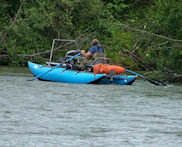 I was faced with this situation and chose to do what I learned as a
trout fisherman. I seek out the
places where there are either no or
very few other anglers. Of course along with the diminished number
of angling competitors comes the fact that there are fewer fish
running the streams. Fewer fish means that you have a smaller window
for error. Spooking the fish
means less chance of finding more without hiking the waterís edge.
In many cases a hike along the riverís edge is difficult, and often
impossible due to the thick shore line vegetation and the depth of
the water. I often employ a Fishcat 13í pontoon boat to locate fish,
and then beach the boat and wade to them. I was faced with this situation and chose to do what I learned as a
trout fisherman. I seek out the
places where there are either no or
very few other anglers. Of course along with the diminished number
of angling competitors comes the fact that there are fewer fish
running the streams. Fewer fish means that you have a smaller window
for error. Spooking the fish
means less chance of finding more without hiking the waterís edge.
In many cases a hike along the riverís edge is difficult, and often
impossible due to the thick shore line vegetation and the depth of
the water. I often employ a Fishcat 13í pontoon boat to locate fish,
and then beach the boat and wade to them.
Just like when stalking trout, you should wear a pair of good
polarized fishing glasses.
Whether you are walking or floating, remember; donít let the fish
see you! Almost anywhere you
fish for salmon the fish are stressed. They have survived the
predators of their days as fry and all of their sub-adult lives. Now
after reaching maturity they must survive commercial fishing fleets,
sea lions, seals, and of course the armadas of sport fishing boats
that lie in wait for them. They are spooky and once they have
spotted you, the chance of getting one to strike a fly is between
slim and none.
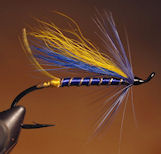 Here is a strategy to consider if you find yourself alone on a
stretch of water and you know that there may be salmon or
steelhead present.
When it comes to fly fishing for salmon, sight fishing is the number
one factor that will contribute to success. First, remember that
wild fish have very good eyesight.
Treat them as if you are trying to sneak up on a bunch of
Bald Eagles. Stay out of the open if you can. As you get nearer to
the water, try to move slowly from tree to tree. And when moving
toward the waterís edge, either use a tree to hide your approach or
crawl into a good position from which to observe the area. Now if
this sounds extreme ask yourself this, what are you there for? If
you are really there to catch fish, then the less the fish know
about your presence, the higher your probability of meeting your
goal. Here is a strategy to consider if you find yourself alone on a
stretch of water and you know that there may be salmon or
steelhead present.
When it comes to fly fishing for salmon, sight fishing is the number
one factor that will contribute to success. First, remember that
wild fish have very good eyesight.
Treat them as if you are trying to sneak up on a bunch of
Bald Eagles. Stay out of the open if you can. As you get nearer to
the water, try to move slowly from tree to tree. And when moving
toward the waterís edge, either use a tree to hide your approach or
crawl into a good position from which to observe the area. Now if
this sounds extreme ask yourself this, what are you there for? If
you are really there to catch fish, then the less the fish know
about your presence, the higher your probability of meeting your
goal.
 By taking the necessary time for observation you will be
able to determine where fish are, and how best to approach them.
When you think you know how youíre going to get to them make very
sure there aren't two or three laying between you and the target
fish. If you spook wild fish and send a couple running, you might as
well toss a few goonies in to go with them. Remember this, fish do
not run for exercise or for fun! Fish flee when there is a danger
present. Enter the water slowly and with as few waves as you can
manage. Your goal is to identify where fish are, and get close
enough to make a good presentation without being spotted.
Your cast must be exact in order not to give yourself away.
Often they know what a fly line is, and it is an identifiable
danger they will respond to. Do not make any false casts over the
area where you know the fish are at. Make your first cast either far
right or left of the real target. Use this first test cast to adjust
your distance and to By taking the necessary time for observation you will be
able to determine where fish are, and how best to approach them.
When you think you know how youíre going to get to them make very
sure there aren't two or three laying between you and the target
fish. If you spook wild fish and send a couple running, you might as
well toss a few goonies in to go with them. Remember this, fish do
not run for exercise or for fun! Fish flee when there is a danger
present. Enter the water slowly and with as few waves as you can
manage. Your goal is to identify where fish are, and get close
enough to make a good presentation without being spotted.
Your cast must be exact in order not to give yourself away.
Often they know what a fly line is, and it is an identifiable
danger they will respond to. Do not make any false casts over the
area where you know the fish are at. Make your first cast either far
right or left of the real target. Use this first test cast to adjust
your distance and to
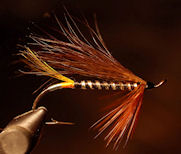 check the sink rate of your fly. You may need
to add weight (a necessary
evil) in order to reach the strata where the fish are. You
will
also need to determine how far upstream and how much line mending
you will need to do in order to have the fly and the fish in the
same place at the same time. If the tackle needs any adjustment make
it prior to casting to the target area. Now that your terminal
tackle is ready and you have your range adjusted, make your
presentation. At this point you will be acutely aware of why our
salmon flies are so colorful. You can, with practice, guide the fly
directly to the fish.
Usually this results in a hook up. If you are not taking the time
and care to give yourself the absolute best odds for success, then
you need to consider treating salmon fishing more like trout
fishing. Think more like a deer hunter and be sneaky. check the sink rate of your fly. You may need
to add weight (a necessary
evil) in order to reach the strata where the fish are. You
will
also need to determine how far upstream and how much line mending
you will need to do in order to have the fly and the fish in the
same place at the same time. If the tackle needs any adjustment make
it prior to casting to the target area. Now that your terminal
tackle is ready and you have your range adjusted, make your
presentation. At this point you will be acutely aware of why our
salmon flies are so colorful. You can, with practice, guide the fly
directly to the fish.
Usually this results in a hook up. If you are not taking the time
and care to give yourself the absolute best odds for success, then
you need to consider treating salmon fishing more like trout
fishing. Think more like a deer hunter and be sneaky.
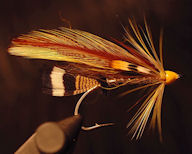 If the river you fish is crowded with other fishermen, then another
strategy will be needed. When I find myself one of many on the
water, I switch methods from stealth to patience. You can choose a
good looking channel and hold that position, or you can go looking
for them. I have spent entire days waiting for fish to move into the
water before me. Sometimes they come and my patience is rewarded,
other times they never show. Marching along the river searching for
the shadow, the movement of a tail or the opening and closing of a
mouth is your second option. Once you do spot a fish and no one is
fishing in the immediate area revert back to stealth mode.
Treat the situation as if you are alone on the river and move
into position slowly and get prepared to make a good presentation as
described earlier in this article. If the river you fish is crowded with other fishermen, then another
strategy will be needed. When I find myself one of many on the
water, I switch methods from stealth to patience. You can choose a
good looking channel and hold that position, or you can go looking
for them. I have spent entire days waiting for fish to move into the
water before me. Sometimes they come and my patience is rewarded,
other times they never show. Marching along the river searching for
the shadow, the movement of a tail or the opening and closing of a
mouth is your second option. Once you do spot a fish and no one is
fishing in the immediate area revert back to stealth mode.
Treat the situation as if you are alone on the river and move
into position slowly and get prepared to make a good presentation as
described earlier in this article.
It is my intention to share tactics that I utilize every time I fish
with you through my writing. My hope is that you will find within
these paragraphs some useful piece of information that will enhance
your fishing especially if you are after salmon or steelhead.
Ard Stetts
The Flies
   

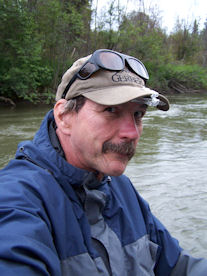
The
Real Skinny, will now be a regular feature of informative
articles written by Ard Stetts for Salmonfly.Net about fly fishing
for salmon and steelhead. Ard Stetts was born in north
central Pennsylvania and now resides in Alaska. He has been tying
classic Salmon, Landlocked Salmon and Featherwing Trout Streamers
for 35 years and has learned from some of the best. Also see
The Flies of
Ard Stetts.

|